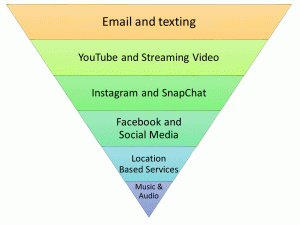In our era of smartphones and mobile streaming American millennials still tune to terrestrial radio, a non-interactive platform created more than a hundred years ago? A recent Nielsen study reveals the sought after 18-24 year old demographic – a highly desirable tech-savvy audience – spend in excess of ten hours weekly listening to good old fashioned AM/FM radio. More interestingly, this consumption is up an hour per week from what Nielsen measured six years ago when these very consumers were only 12-17 years old. Likely because newer app-centric audio ignores the valuable lessons learned in the golden age of wireless and as a result humble AM/FM remains profitable and lucrative today. Let’s explore how cognitive computing reinvents radio for the 21st century mobile audience by capturing the best of terrestrial radio and making it interactive.
It’s not just millennials tuning in droves to radio to quench their thirst for audio; 93% of all Americans age 12 and up listen weekly to AM/FM radio. Compare five major differences distinguishing radio from apps:
- Passive vs. active listener: radio does all the thinking for the listener; once a suitable station is tuned-in, listener willingly abdicates content control to broadcaster. For typical listeners audio is background to other activities like commuting or work, and consumed at length when eyeballs and attention may be focused elsewhere. By contrast, app user experience requires an active listener and more regular visual interaction with content. App interfaces demand thought. Enhanced ability to explore a particular genre or search for obscure titles might be delightful features, but mobile listeners aren’t looking for the distraction of constant involvement with their audio. They just want good content.
- Instant content vs. hurdles: as soon as the radio is on and tuned, audio is already streaming from it without buffering delays or obstacles. Radio doesn’t gate content behind a registration form, and there is no buffering or loading delay to the immediacy service. Mobile apps are optimized with hurdles to adoption that are off-putting to prospective listeners seeking instant audio gratification. Registration, content downloads and app upgrades together dissuade more widespread adoption and use.
- Friendly, familiar and standardized vs. NOT: Anyone from anywhere on the planet can walk up to any radio from any manufacturer and operate it expertly. Radios are optimized for simplicity and sound; even changing stations can be done eyes-free on most. But every app operates differently, presents its own player and interface, and requires a learning curve. Sometimes an app update alters the interface, or demands the listener download that latest update before continuing (another hurdle).
- Pervasive platform and access for all vs. higher-income visual-centric devices: Every citizen owns at least one radio in some form; the entire population can be touched by AM/FM using devices they already possess and use. People of greater or lesser means, limited literacy, people who are visually impaired or remotely situated, all have equal access to the same radio that pervades the airwaves. Apps are optimized only for smartphones and Americans that can afford them. Despite audio being the ideal theater of the mind for the visually impaired, mobile app visual-centricity prevents easy access and manipulation of content by this audio-seeking market segment representing nearly ten percent of the population.
- Cost and penalty free vs. third-party premiums required: These fundamental flaws of the mobile app model ultimately limit wide embrace by making the following prerequisite of any listener: a) Ownership of a smart device, and b) Ability to sustain monthly carrier surcharges of $20-$50 to send and receive data.
The carrier surcharge does not include the monthly subscriptions many audio apps rely on for revenue. It is another hurdle – this one financial – for a prospective listener to contend with before they even consider paying additional monthly fees specifically for a desired mobile app.

Mobile Data User’s Hierarchy of Needs
As explained in my earlier blog, Why Limiting Your Audio Content Mobile Distribution to Smartphones Is a Dumb Idea, I introduced the mobile data user’s hierarchy of needs, which explains the challenge for listeners seeking audio. Smartphone owners, particularly those on metered data plans, prioritize consumption based upon their monthly gigabyte allowance from the carrier. Email, video, social media, gaming and texting will always be those gig-consuming applications that any smartphone owner on a limited plan prioritizes over audio. There’s no greater competition to a mobile app than sharing a smartphone screen with 27 other apps or more – many visually stimulating – all simultaneously competing for the user’s attention.
There are no outside recurring costs to conventional AM/FM radio consumption. That $20-$50 data fee sucked-up by carriers might have been spent directly towards subscription audio services if only those services did not require data.
Consider lowly radio then, which still retains substantial mindshare for most Americans as they go about their every day. American radio generates in excess of US$ 17 billion in revenues annually. Have struggling mobile app audio streaming providers been overthinking what it means to deliver personalized wireless audio? The next great wireless audio revolution must emulate radio.
Radio works so well, there’s only one killer app that can transform the medium and reinvigorate the entire industry for another hundred years: interactivity. Here’s how cognitive computing reinvents radio via conventional telephony without building out infrastructure or deploying new devices or apps:
- Choose a wireless platform as immediately pervasive as radio: rather than serve wireless audio only to smart devices via data; serve it to all telephones via voice. Every mobile phone is a radio…a two-way radio. These radios are almost exactly like AM/FM radios, except operating on a different frequency and with twelve extra buttons and a microphone allowing interactivity. These ubiquitous devices and the infrastructure that supports them are massively entrenched and covering more than 94% of the entire planet’s population (100% North America). As or more pervasive than radio. And the coverage is national, not regionally scattered.
- Serve audio instantaneously: without download or buffering requirements there is little to drive a potential listener away if the program begins immediately when requested. Personalization and on-demand are features of a user interface that should not of themselves create barriers to the more immediate desire for instant audio gratification. Content delivered on the voice line suffers no lag. Cognitive computing reinvents radio by learning from the listener with each interaction, so that on return visits the audio instantly presented to the listener is more and more suited to their recorded habits and tastes.
- Make the user interface common, standardized and familiar. Regardless of handset or device, as with radio, any listener from anywhere on the planet can grab virtually any telephone built by any manufacturer and know intuitively how to make and conduct a call. Instead of forcing handset users to learn new interfaces for audio, design the audio interface to mimic the simplicity familiar to telephony and radio. Instead of visually intensive screens and finger swipes unique to each app, the easiest interface to learn is one that is already universal, familiar and tele-centric: voice commands, audio and twelve button keypad.
- Eliminate third party costs that stand in the way of prospective listener access, adoption, use. Whereas data consumption places a premium cost on the smartphone user, voice connectivity is the most basic and fundamental function of all the billions of handsets and wired devices on earth. Making an interactive audio service independent of the carriers’ usage-limiting metered data plans means no penalty to listeners for massively consuming audio (and advertising) on their phones.
- Personalization, navigation, on-demand – put it all in the cloud: in many cases losing a smartphone also means losing purchased apps, content downloads, bookmarks and personalized settings and features on that phone. Cognitive computing reinvents radio and the entire concept of content personalization. Apps rely on smartphones and their local memory, processing power and display. Radio never had need for locally intelligent devices, and a reinvented radio deployed with a cloud-based AI backbone similarly requires no device intelligence. Using any phone, anywhere, anytime, a listener can access all their history, content and personalization from any device.
 If you were going to introduce a consumerized audio content platform, would you fashion it taking lessons from the Internet, or from Radio? Would you target only display-centric compute-capable devices held by a subset of prospective listeners, or would you target devices with an install-base and ease-of-access that rivals radio at a penetration rate of nearly one device for each human on earth? Cognitive computing reinvents radio.
If you were going to introduce a consumerized audio content platform, would you fashion it taking lessons from the Internet, or from Radio? Would you target only display-centric compute-capable devices held by a subset of prospective listeners, or would you target devices with an install-base and ease-of-access that rivals radio at a penetration rate of nearly one device for each human on earth? Cognitive computing reinvents radio.
Radio remains massively entrenched in our population because it is widely accessible without hurdles to adoption and without exhausting one’s data allowance. By diverting streaming audio consumption to the audio-optimized voice line we resolve the conundrum of the Mobile Data User’s Hierarchy of Needs and create new access points to interactive audio for those subscribers using feature phones or smartphones – all phones – essentially doubling-to-tripling the immediate prospective audience available to discover mobile streaming audio for the first time.
The mobile phone is a two-way radio. It transmits as well as receives, which makes it an interactive device, which conventional radio is not. SARA teaches us how cognitive computing reinvents radio. The technology of SaraConnects instantly transforms any telephone into a smart, personalized interactive radio. Access requires only a dialed telephone call or text. No apps, no data, no gigs, no restrictions or hurdles to trial. We are looking for technology and content partners ready to reinvigorate, monetize and truly consumerize wireless audio for the next century: https://saraconnects.world/contact






